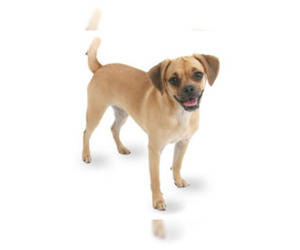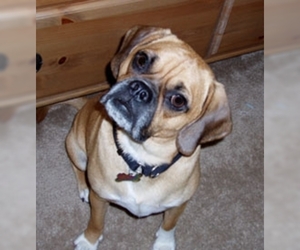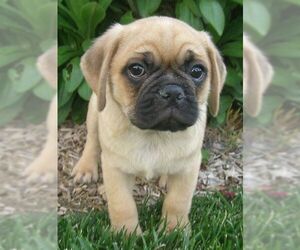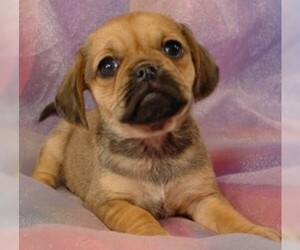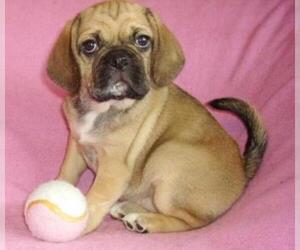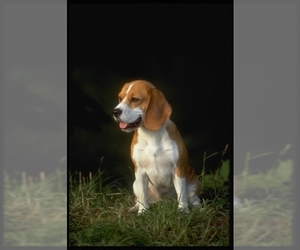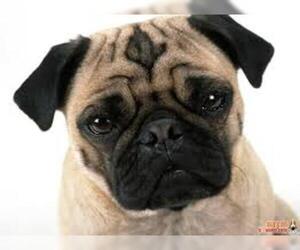All about Puggle dog breed
A.K.A. :pug-beagle, pugle, beagpug
Size
Grooming requirements
Exercise requirements
Good with other dogs
Watchdog ability
Energetic
Training requirements
Playful
Affectionate
Good with other pets
Good with children
Good with strangers
Winter
Summer
Healthiness
Protective
Life Span
| Mixed Breeds | Member |
| Breeds A - Z | P |
| Breeds by Group | Hound Hunting |
| Breeds by Trait | Good With Kids Low Shedding |
| Overview: | The Puggle, a charming cross between a Beagle and a Pug, originated in the 1980s as a designer breed in the United States, quickly gaining popularity for its unique blend of traits. Physically, Puggles typically sport a sturdy, muscular build with a short, smooth coat that comes in various colors, often resembling the Beagle's tri-color or the Pug's fawn with a black mask; their floppy ears and expressive eyes are unmistakable. Temperamentally, they are known for being friendly, affectionate, and generally good-natured, inheriting the Beagle's playful curiosity and the Pug's laid-back charm, though they can possess a stubborn streak. This makes them excellent family pets, adaptable to both houses with yards and apartment living, provided they receive regular exercise. While generally healthy, potential owners should be aware of predispositions to conditions like hip dysplasia, patellar luxation, and respiratory issues, common in their parent breeds, making responsible breeding and regular veterinary check-ups crucial for their well-being. |
F.A.Q.
All You Need to Know About the "Puggle" Breed
The Puggle is a delightful designer dog, a cross between the playful Beagle and the charming Pug. Originating in the 1980s, these compact companions offer a fantastic blend of their parent breeds. Puggles are renowned for their friendly, outgoing, and affectionate temperament, making them wonderful family pets and excellent with children. Physically, they typically have a medium-short coat, often fawn, black, or tri-color, and possess the Pug's adorable wrinkles combined with the Beagle's longer snout, which helps with potential breathing issues. Their size makes them adaptable to apartment living, though a small yard is always appreciated. They require moderate exercise—daily walks and playtime—and minimal grooming, mostly brushing a few times a week. Common health considerations can include hip dysplasia and certain respiratory issues, inherited from their parent breeds, so choosing a reputable breeder is crucial for a healthy Puggle puppy.The average Puggle weight is 20-30 pounds. Adult Puggle size typically ranges from 18 to 30 pounds. While there can be slight variations, male Puggles are often at the higher end of this range, and females at the lower end. A healthy weight for Puggle ensures optimal well-being for this popular crossbreed.
Curious about the Puggle height and how tall these adorable dogs get? A full-grown Puggle typically stands between 10 to 15 inches tall at the shoulder. This average size makes them a compact and versatile companion, fitting well into various living situations.
Like many breeds, you might see some slight variation in a Puggle’s adult height. While there isn't a significant difference based on gender, individual genetics from their Beagle and Pug parents play a role. A Puggle with stronger Beagle genetics might lean towards the taller end of the spectrum, while one with more dominant Pug genes could be a bit shorter and stockier. This natural range contributes to the unique charm of each Puggle!Puggle colors are diverse, reflecting their Beagle and Pug heritage. Common colors include various shades of fawn (often with a black mask), black, tan, and combinations like black and tan, or tri-color (black, tan, and white). You'll also find Puggles in white with patches of other colors, and sometimes solid white or cream. Since Puggles are a hybrid breed, they are not recognized by major kennel clubs like the AKC, so there are no "AKC recognized Puggle colors."
While the most typical Puggle coats are in the fawn and black spectrum, rare coat types and exotic Puggle variations can occasionally appear. These may include brindle (a tiger-striped pattern) or even chocolate/liver, though these are less common. Truly rare or highly unusual colors like blue, lilac, or merle are extremely unlikely and would typically indicate the presence of other breeds in the lineage, or genetic anomalies. Always be cautious when encountering breeders claiming "designer" or "rare" colors for a significantly higher price, as these are often not naturally occurring within the Puggle's established genetic pool and may be a red flag regarding breeding practices.The Puggle personality is generally a delightful blend of their parent breeds, the Beagle and the Pug. Known for their friendly and affectionate nature, Puggles are often described as charming companions. Their temperament of Puggle is typically outgoing and sociable, making them excellent family pets. They display strong loyalty to their owners and thrive on companionship, often seeking to be part of all household activities.Puggles are quite adaptable to apartment living provided they receive adequate daily exercise. While not excessively high-energy, they do enjoy walks and playtime. Their curious Beagle heritage means they appreciate exploring, while the Pug influence can make them quite content to cuddle on the couch.When it comes to children and other pets, Puggles typically exhibit a gentle and patient demeanor. They are generally good with children, especially if raised with them, and often enjoy playing. Their sociable nature also extends to other animals, and they usually get along well with other dogs and cats, particularly when properly introduced and socialized from a young age. Early socialization is key to ensuring a well-adjusted and harmonious Puggle.
The Puggle temperament is generally a delightful blend of its parent breeds, making them a popular companion dog. They are typically very friendly and sociable, often greeting strangers with enthusiasm. Puggles are known for their loyal and affectionate nature, forming strong bonds with their families and thriving on human companionship. This makes them excellent family pets, as they are usually good with children, though supervision is always recommended with very young kids due to their playful energy. Their sociability often extends to other pets, and they usually get along well with other dogs and cats, especially if introduced early.
Puggles are quite adaptable to apartment living as long as they receive adequate daily exercise, as they have moderate energy levels. They enjoy playtime and walks but are also content to cuddle on the couch. While generally eager to please, Puggles can inherit a touch of the Beagle's independent spirit, leading to occasional stubbornness. Consistent, positive reinforcement training is key. They can also be somewhat sensitive to harsh reprimands, so a gentle approach works best. Their charming personality traits make them a joy to live with for those seeking an affectionate, playful, and loyal companion.Puggle care involves a blend of its Beagle and Pug heritage. Here's a quick guide to their daily maintenance:
Grooming: Puggle care includes regular brushing (2-3 times weekly) to manage shedding, which can be moderate. Bathe as needed, typically every 4-6 weeks, or when dirty. Pay close attention to ear hygiene; clean ears weekly to prevent infections.Exercise: While often playful, Puggles are generally a low-energy dog breed. Daily walks (30-45 minutes) and some playtime are usually sufficient to keep them happy and prevent obesity. Avoid strenuous exercise in hot weather due to their brachycephalic (short-nosed) anatomy.Dietary Considerations: Puggles have a hearty appetite and are prone to weight gain. Feed a high-quality dog food in controlled portions, divided into two meals daily. Monitor calorie intake and avoid excessive treats. Consult your vet for specific dietary recommendations, especially for puppies or senior Puggles.Wrinkle and Ear Cleaning: If your Puggle inherits Pug-like facial wrinkles, regular cleaning is crucial to prevent skin fold dermatitis. Gently wipe wrinkles daily with a damp cloth and ensure they are dry. Clean ears weekly with a vet-approved solution to prevent ear infections, a common issue for dogs with floppy ears.Climate Sensitivity: Due to their brachycephalic snouts, Puggles are sensitive to heat and humidity. They can overheat quickly, so avoid vigorous exercise during warm weather and ensure they always have access to shade and fresh water. They also don't tolerate extreme cold well and may need a coat in winter.Common Health Concerns & Health tips for Puggle: Be aware of common health issues. Skin issues, including allergies and skin fold dermatitis, are possible. Dental care is paramount; brush teeth daily or provide dental chews to prevent periodontal disease. Weight management is key to preventing joint problems and other obesity-related ailments. Regular veterinary check-ups are essential for early detection and prevention of health issues.Puggle Activity Level: Moderate & Adaptable
How active are Puggles? Puggles typically have a moderate activity level, blending the Beagle's playful curiosity with the Pug's laid-back charm. They are not hyperactive but do require regular stimulation. Expect short bursts of enthusiastic play followed by longer periods of rest and napping.Exercise Needs: Daily exercise is crucial for a healthy Puggle. Aim for 30-60 minutes of combined activity each day, which can include two to three shorter walks, especially in the morning and evening. They enjoy exploring and sniffing, making leash walks a favorite. Playtime preferences lean towards interactive games like fetch (for short periods) and engaging with puzzle toys. Supervised playtime in a securely fenced yard is also beneficial.Brachycephalic Limitations: Due to their brachycephalic (short-nosed) anatomy inherited from the Pug, Puggles are prone to overheating. It's vital to limit strenuous exercise during hot or humid weather. Avoid walks during the hottest parts of the day and ensure constant access to fresh water and shade. Watch for signs of heavy panting or distress.Suitability: Puggles can adapt to various households. They are generally suitable for families who enjoy daily walks and some interactive play, but also appreciate a dog that's content to cuddle on the couch. While not ideal for highly active families seeking a running or hiking partner, they are a good match for moderately active individuals or low-energy households willing to commit to consistent, gentle exercise. Their adaptable nature makes them a beloved companion for many.Because the Pug parent is a brachycephalic breed, many Puggles inherit a shortened muzzle, making them prone to Brachycephalic Obstructive Airway Syndrome (BOAS). Applying brachycephalic dog care strategies—such as avoiding strenuous activity in hot weather, using a harness instead of a collar, and monitoring breathing during exercise—can help reduce respiratory stress. Their compact build and shorter muzzle also contribute to heat sensitivity, so they should always have access to shade, water, and cool resting areas. Additionally, their Beagle lineage may predispose them to spinal problems such as arthritis or intervertebral disc disease, particularly if they jump frequently from heights or carry excess weight.
Understanding how to keep Puggle healthy involves scheduling regular veterinary checkups, early screening for joint, respiratory, and skin conditions, maintaining a balanced diet to prevent obesity, and providing moderate but consistent exercise. Grooming routines should include cleaning skin folds, brushing to reduce shedding, and dental care to prevent oral disease. With attentive care, Puggles can enjoy a loving, playful life of 10–15 years.
Breed Breakdown: What Experts Say About the Puggle
I would rate the "Size" trait of the Puggle breed a 4.Puggles are a small to medium-sized dog breed, typically inheriting a compact build from their Pug parent and a slightly longer frame from their Beagle parent. They generally stand between 13 to 15 inches tall and weigh anywhere from 18 to 30 pounds. While certainly not "toy" sized, they are significantly smaller than most medium to large breeds. Their body structure is sturdy and muscular, but not bulky. Compared to other companion dogs, they fall squarely in the smaller end of the spectrum, being larger than a Chihuahua but considerably smaller than a Golden Retriever. This makes them very well-suited for apartment living, as they don't require vast amounts of space to move around comfortably. Their moderate size also makes them excellent travel companions, fitting easily into car seats or airline carriers designed for smaller pets. For households with space constraints, the Puggle is an ideal choice, offering a robust and playful personality in a manageable package.
I would rate the Puggle's grooming requirements a 5.While not extremely high-maintenance like a poodle or some long-haired breeds, the Puggle is certainly not a wash-and-wear dog either. Their coat, a mix of the Beagle's short, dense fur and the Pug's fine, short coat, can vary but generally results in a moderate shedding level year-round. This means regular brushing (a few times a week) is necessary to manage shedding and keep their coat healthy. They typically don't have the extensive skin folds of a purebred Pug, but some Puggles may inherit a degree of wrinkling around the face that will require occasional cleaning to prevent irritation or infection. Their floppy Beagle-like ears are prone to trapping moisture and debris, making weekly ear checks and cleaning essential to prevent infections. Nail trims are standard for all dogs and need to be done every few weeks. Bathing needs are moderate, typically every 4-8 weeks, or as needed. While generally a healthy mix, like their parent breeds, they can be susceptible to some skin allergies or sensitivities that might require specialized shampoos or more frequent attention to their coat and skin, pushing them a bit beyond the "easy" category for grooming. Overall, they require consistent, routine care, but not the specialized, time-consuming effort of a truly high-maintenance breed.
I would rate the Puggle's "Exercise Requirements" at a 6 out of 10.While Puggles inherit some of the more laid-back tendencies of the Pug, the significant influence of the Beagle parent means they are far from couch potatoes. They possess a good amount of energy and a strong desire to explore and sniff, characteristic of scent hounds. Daily activity recommendations typically involve at least 30-60 minutes of moderate exercise, often broken into two sessions. This could include brisk walks, enthusiastic playtime in a securely fenced yard, or even some light jogging if the weather is cool and the individual Puggle's breathing is unhindered.Their tolerance for sustained movement is generally good, but the brachycephalic influence from the Pug means owners must be *very mindful of heat and overexertion*. Puggles can overheat quickly, so exercise should be avoided during the hottest parts of the day, and they should always have access to water and shade. While not typically built for intense agility, some Puggles with a more Beagle-like build might enjoy it at a recreational level. They definitely thrive with structured routines that include both physical activity to burn off energy and mental stimulation to satisfy their intelligent and sometimes mischievous minds, rather than thriving with minimal activity. Without adequate exercise, they can become bored, destructive, or prone to weight gain.
I would rate the Puggle's watchdog ability as a 5 out of 10.While the Puggle certainly inherits a degree of alertness from both the Beagle and the Pug, its effectiveness as a true watchdog is moderate at best. The Beagle's keen sense of smell makes it generally aware of its surroundings, and it's known for its vocalizations, particularly its baying. The Pug, though small, can be surprisingly assertive and often barks at unfamiliar sounds or people. When combined, the Puggle is likely to be a responsive barker to new stimuli. It will definitely alert you to someone at the door or an unusual noise outside with a series of barks. This makes them capable of providing meaningful early warnings in a home environment, letting you know that something is amiss.However, their territorial instincts are not particularly strong, and their inherent friendliness often overrides any protective tendencies. While they will bark, it's more of an announcement than a deterrent. They are more likely to greet an "intruder" with curiosity or a wagging tail once they realize it's a person, rather than displaying any significant aggression or willingness to deter. They lack the imposing presence or inherent wariness of breeds truly bred for guarding. Therefore, while not entirely passive, their warning is often their main contribution, and they are unlikely to follow up with any protective action. They are more of a "doorbell" than a "security guard."
I would rate the "Good with Other Dogs" trait of the Puggle breed a 7 out of 10.Puggles generally inherit a good disposition towards other dogs from both their Beagle and Pug parents. Beagles are typically pack animals, thriving in canine company and exhibiting a friendly, non-aggressive nature. Pugs, while sometimes preferring human attention, are also known for being sociable and getting along well with other dogs, often enjoying playful interactions. This combination usually results in a Puggle that is quite amiable with unfamiliar dogs, showing curiosity rather than hostility. They are often adaptable to dogs of different sizes and energy levels, particularly if properly socialized from a young age. While generally not prone to aggression or dominance, like any breed, a lack of early socialization can lead to shyness or a preference for human company over canine. However, in multi-dog households, Puggles typically integrate well and enjoy having canine companions. They generally thrive in canine company and don't usually require extensive careful introductions beyond what's typical for any new dog, though consistent positive reinforcement and training always help to ensure peaceful coexistence.
I'd rate the Puggle's "Energetic" trait a 6 out of 10.The Puggle inherits a interesting mix of energy levels from its parent breeds. The Beagle brings a significant amount of the energetic drive, known for its stamina, scent-driven curiosity, and need for moderate to high exercise to prevent destructive behaviors. They love to explore and can go for long walks or hikes. On the other hand, the Pug, while playful, is generally a more laid-back breed, content with shorter bursts of activity and a lot of napping.As a result, the Puggle is typically more active than a Pug but less of a tireless athlete than a Beagle. They enjoy play sessions, walks, and mental stimulation, and can certainly be playful and enthusiastic. However, their brachycephalic (short-nosed) anatomy, inherited from the Pug, is a crucial factor in their stamina and exercise tolerance. This can make them prone to overheating and respiratory difficulties during intense or prolonged physical activity, especially in warm weather. While they have the inclination to be active, their physical limitations prevent them from being extremely high-energy dogs capable of extended athletic pursuits. They need regular, moderate exercise to stay healthy and happy, but excessive or strenuous activity should be carefully managed to avoid health risks.
I'd rate the Puggle's "Training Requirements" at a 6 out of 10. While not the most difficult breed to train, they're definitely not a "set it and forget it" kind of dog. Puggles inherit a good dose of intelligence from both the Beagle and the Pug, making them capable of learning a wide range of commands. However, their stubborn streak, particularly from the Beagle side, can make training a test of patience. They have a moderate attention span, but can be easily distracted by interesting scents or sounds. Responsiveness to commands can vary; some Puggles are eager to please, while others will weigh the perceived benefit of obeying against the immediate gratification of their current activity.Consistency is absolutely crucial with a Puggle. Inconsistent training will quickly lead to them "testing the waters" to see what they can get away with. Positive reinforcement is highly effective, as they are food-motivated and generally enjoy praise and play. Harsh corrections are unlikely to work and may cause them to shut down or become more resistant.This breed is moderately beginner-friendly, but new owners should be prepared to invest consistent time and effort into training, especially during puppyhood. While structured routines are beneficial for any dog, they are particularly important for a Puggle to establish clear expectations and prevent unwanted behaviors from taking root. Experienced handling isn't strictly necessary, but an owner who understands the importance of consistency and positive reinforcement will have a much smoother training journey.
I'd rate the Puggle's "Playful" trait an 8 out of 10.Puggles inherit a wonderful blend of their parent breeds, resulting in a naturally spirited and enthusiastic companion. They definitely lean towards the more energetic and fun-loving side compared to many other small companion dogs. You can expect a Puggle to have a good amount of pep in their step, often initiating play with their humans or other pets. They generally have a strong love for games, whether it's a vigorous session of fetch, a puzzle toy, or just a good old-fashioned romp in the yard. Their Beagle lineage contributes to a curious and often boisterous nature, while the Pug's affectionate and sometimes comical antics add to their charm. They are generally responsive to toys and playtime, showing clear excitement and engagement. While they also enjoy a good cuddle session, they are far from inactive and will thrive with regular opportunities to burn off energy and engage in playful interactions throughout the day. Their attention-seeking behavior is often expressed through playful nudges or bringing you a toy, reflecting their desire for continued interaction and fun.
I would rate the Affectionate trait of the Puggle at a 9.Puggles are renowned for their incredibly loving and people-oriented nature. They inherit the Beagle's desire for companionship and the Pug's need for physical closeness, resulting in a dog that truly thrives on affection. They will actively seek out human interaction, often following their family members from room to room just to be in their presence. Expect frequent requests for lap-sitting, leaning, and full-body cuddles. Puggles are highly loyal and can be quite sensitive to their owner's moods, offering comfort when they sense distress. While not typically described as clingy to the point of anxiety, they certainly prefer being with their people over being alone, and their happiest moments often involve snuggling up close. They are a breed that genuinely melts into their families, embodying a deep and unwavering love for their human companions.
I'd rate the "Good with Other Pets" trait of the Puggle at a 7.Puggles generally inherit a friendly and amiable disposition from both their Beagle and Pug parents, making them quite adaptable in multi-pet households. Beagles are renowned for their pack mentality and tend to get along well with other dogs, a trait often passed on to Puggles. Pugs are also typically non-aggressive and enjoy companionship, whether human or animal. Their prey drive is moderate; while a Puggle might show some interest in chasing a cat, it's usually more playful than predatory, especially with proper early introduction and socialization. Resource guarding can occur, as with any breed, but it's not a prominent trait for Puggles and can be mitigated through training. They are naturally sociable and generally enjoy the company of other animals, but like all dogs, benefit immensely from early and consistent socialization to ensure peaceful coexistence. While they don't typically require intensive training or constant supervision to be good with other pets, responsible owners should always facilitate positive introductions and reinforce good behavior to ensure everyone in the household gets along harmoniously.
I'd rate the "Good with Children" trait of the Puggle a 7 out of 10.The Puggle generally scores well in a family setting, inheriting a pleasant blend of traits from its parent breeds. From the Beagle, it often gets a playful and curious nature, making it a fun companion for active children. They typically enjoy games and outdoor activities, which can be a big plus for energetic kids. The Pug influence usually contributes to their affectionate and companionable side; Puggles often love to be part of the family action and enjoy cuddles. They are generally patient and tolerant, particularly if they are well-socialized from a young age. Their moderate size also makes them less likely to accidentally knock over smaller children compared to larger breeds.However, the "7" rather than a higher score acknowledges a few nuances. While generally good-natured, some Puggles can inherit the Beagle's tendency to follow scents, which might lead them to wander if not securely fenced, and their independent streak can mean they're not always focused solely on children. They can also be quite vocal, with a bay or bark that might startle very young or sensitive children, although this isn't usually aggressive. While generally gentle, like all breeds, they benefit immensely from early socialization and consistent positive reinforcement training to ensure they thrive in a bustling family environment. Supervised interactions, especially with toddlers, are always recommended to teach both the dog and the children how to interact respectfully and safely.
I'd rate the Puggle's "Good with Strangers" trait a 9 out of 10.Puggles are generally very sociable and welcoming dogs, inheriting a good deal of their friendly disposition from both the Beagle and the Pug. They typically greet unfamiliar adults with enthusiasm, often seeking attention and being eager to sniff and say hello. Their friendly nature makes them naturally outgoing, and while early socialization is always beneficial for any dog, Puggles tend to be quite comfortable in public or guest-filled environments without extensive training. They are not prone to excessive barking or guarding around strangers, preferring to make new friends rather than view newcomers with suspicion. Their adaptability and affable temperament make them excellent companions for households that frequently have visitors or enjoy taking their dog out and about.
I would rate the Puggle's winter tolerance at a 4. While they inherit some cold tolerance from the Beagle, the significant influence of the Pug, with its brachycephalic anatomy and single, short coat, significantly reduces their resilience. Puggles are prone to respiratory issues in cold weather due to their shorter snouts, making them susceptible to breathing difficulties and increasing their risk of hypothermia. Their moderate body fat offers some insulation, but it's often not enough to compensate for their thin coat in truly cold conditions. They are generally small to medium-sized, meaning they lose heat more quickly than larger breeds. Therefore, Puggles definitely require special care during winter months, including warm coats or sweaters, limited outdoor exposure, and careful monitoring for signs of discomfort or hypothermia, making them less suited for prolonged outdoor activity in cold climates compared to more cold-hardy companion dogs.
I would rate the "Summer" tolerance of the "Puggle" breed a 3 out of 10.Puggles inherit a significant risk factor for heat sensitivity from their Pug parent: brachycephaly. While not as extreme as a purebred Pug, their shortened snout can still impede efficient panting, the primary way dogs regulate their body temperature. This anatomical feature makes them less effective at cooling themselves down compared to longer-nosed breeds. Beagles, while generally more tolerant, are still active dogs that can overheat if not managed in hot weather. The Puggle's moderate activity level, combined with their compromised respiratory system, means they are at a higher risk of heatstroke than many other companion dogs. They struggle to dissipate heat effectively, leading to rapid increases in core body temperature. Therefore, Puggles absolutely require special care in summer months compared to many other companion dogs. This includes strictly limited outdoor activity during peak heat, often only allowing short walks in the early morning or late evening, and constant access to air conditioning or a cool, indoor environment. Close monitoring for signs of overheating like excessive panting, lethargy, or drooling is crucial.
I would rate the Puggle's "Healthiness" trait as a 6 out of 10.While the Puggle benefits from some hybrid vigor, potentially reducing the incidence of certain breed-specific ailments found in its parent breeds, it still inherits a mixed bag of predispositions. Puggles often fall victim to the brachycephalic (short-nosed) issues of the Pug, including breathing difficulties, a propensity for overheating, and dental problems. From the Beagle side, they can inherit a predisposition to epilepsy, intervertebral disc disease, and certain eye conditions. Joint problems like patellar luxation and hip dysplasia can also be a concern, although less consistently than in some larger breeds. Their floppy ears from the Beagle parent can make them prone to ear infections, and skin fold dermatitis from the Pug parentage can occur. Their life expectancy is generally in the 10-15 year range, which is fairly typical. Responsible breeding can significantly mitigate these risks by screening parent dogs, but the fundamental genetic predispositions remain. Compared to some extremely robust working breeds, Puggles require moderate maintenance, primarily due to potential respiratory concerns and a need for diligent care of their skin folds and ears. They are generally more robust than a purebred Pug, but not as bulletproof as some other companion dogs.
I would rate the "Protective" trait of the Puggle a 3 out of 10.Puggles inherit traits from both Beagles and Pugs, neither of which are known for strong protective instincts. They are generally friendly, good-natured, and eager to please. Their alertness might be moderate – they'll bark at a doorbell or something unusual, but this is more due to curiosity or excitement than a perceived threat. Territorial instincts are low, and while they are loyal to their owners, this loyalty manifests as affection and companionship, not a desire to defend. Their reaction to strangers is typically one of curiosity or a wagging tail rather than suspicion or aggression. Therefore, the Puggle is very much a companion dog and not at all suitable as a watchdog or guard dog that could offer meaningful protection in a household setting. Their "bark" is usually worse than their "bite" – and even that bark is often just a friendly hello.
I would rate the Puggle's "Life Span" trait as a 7.This places them in the average to slightly above-average category compared to other companion dogs. Puggles typically enjoy a lifespan of 10 to 15 years, which is a respectable range. This is generally bolstered by the genetic diversity gained from being a hybrid, often benefiting from "hybrid vigor" which can reduce the incidence of some breed-specific diseases. While both parent breeds, the Beagle and the Pug, have their own predispositions (Beagles to ear infections and some joint issues, Pugs to respiratory problems due to their brachycephalic nature, and eye issues), responsible breeding aims to mitigate these by selecting healthy parents. Good care, including a balanced diet, regular exercise, and preventative veterinary check-ups, significantly contributes to a Puggle reaching the higher end of their life expectancy. They are not considered exceptionally long-lived, but also not notably short-lived.
Puggle Dogs for adoptionSee all dogs for adoption
Puggle BreedersSee all breeders
Similar Dog Breeds for Puggle
Breed Mixes of Puggle
Quick Breed Selector 0 - not important, 1 - smallest, 10 - largest
Variants & Mistakes :Pugel, Pugle, Puggyl, Puggl, Puggel, Pugglel, Puglle, Pugglle, Puggul, Puggil, Puggell, Pugglu, Puggli, Puggleo, Pugglea, Puggelo, Puggeal, Puggeul, Puggeol, Puggleu, Pugglei, Puggleee, Puggleie, Pugglie, Puggiel, Pugghl, Pugglee, Puggull, Pugge, Pugg, Puggei, Puggll
